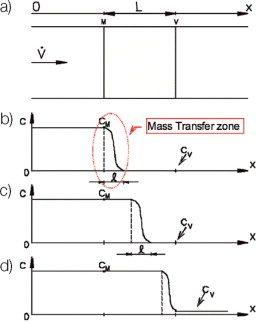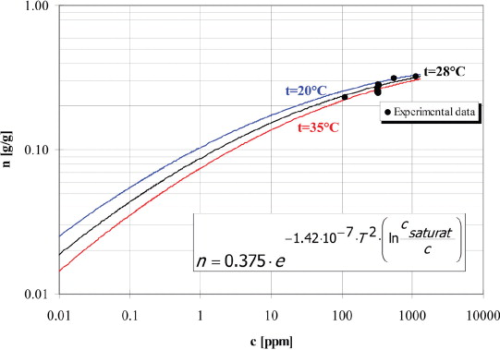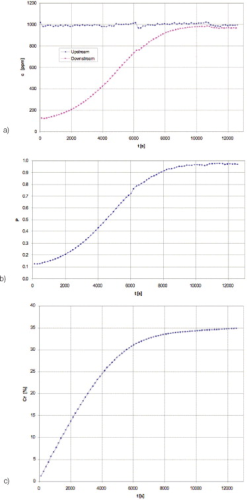



Many test methods exist for evaluating gaseous-contaminant filtration media, and a few for evaluating functional filters and other devices. These test methods are designed primarily for use in product quality control and to rank products. Designers of filtration devices and HVAC (Heating, Ventilating and Air-Conditioning) systems engineers, however, need test data which allow calculation of device performance under actual operating conditions. End users need data to determine system maintenance costs. We call such tests design parameter tests. The natures of the three test groups are as follows:
Quality control tests
These are generally simple and inexpensive, presumably run on each media or component lot.
Product differentiation tests
These are also relatively simple, involving feeding of specific contaminants in airstreams passing through devices or media samples, and measuring the contaminant removal efficiency. These tests are usually run at product market introduction, to provide some (limited) performance data for clients. They may also be used later to confirm manufacturers' data.
Design parameter tests
Design parameter tests are much more demanding. To be fully informative, they require lengthy feed of a range of contaminants at low concentrations. High-sensitivity gas contaminant detectors may be required to obtain data for a useful array of contaminants at concentrations met in actual applications. Such tests are normally performed during the development of a new product. They are rarely published by suppliers.
This discussion is limited to devices and media used in building HVAC systems, and a few studies which help define test conditions. Tests for respirators, chemical warfare agent protection, nuclear reactor safety systems, and applications involving special conditions are too complex to be contained in this article.
Quality control tests
ASTM (originally known as the American Society for Testing and Materials) has produced several standards which test the properties of granular activated carbon. Those that belong in our ‘Quality Control' category are: D2854 (Apparent density); D2862 (Particle size distribution); D2866 (Ash content); D2867 (Moisture content); D3466 (Ignition temperature); D3802 (Ball-pan hardness); D3838 (pH); D5159 (Dusting attrition); and D5832 (Volatile matter content).
Japanese standard JIS K1474 Test methods for activated carbon contains sections covering the subjects of the first seven ASTM standards listed above, plus adsorption tests and tests for the amounts of impregnants.
There are catalysts that can alter the nature of some gaseous contaminants, and therefore may have uses in HVAC systems. Catalyst carriers, such as alumina and silica, can be impregnated with reactive chemicals, becoming chemisorbers. There are ASTM standards for quality control of catalysts and catalyst carriers (but not for chemisorber impregnants). Among these are: D4058 (Attrition and abrasion); D4164 (Tapped packing density); D4513 (Particle size distribution by sieving); D5757 (Attrition and abrasion by air jets); D7084 (Crush strength); and D5153 (Palladium content).
These tests help to maintain product uniformity, assisting the manufacturer of adsorption cells, but are useless in calculating the contaminant-removal efficiency of adsorption/chemisorption cells, or predicting their service life.
Product differentiation tests
The most important design parameters for HVAC applications using purely adsorptive media are pressure loss characteristic, working capacity and retentivity. Pressure loss characteristic is the pressure drop across a specified depth of media as a function of superficial bed velocity. Activity (also sometimes called capacity) is measured by feeding air containing a specified contaminant concentration at a specified temperature and pressure. The capacity value is the number of grams of contaminant gained per gram of medium when the medium is saturated, i.e. ceases to adsorb any additional contaminant. Retentivity is measured by passing uncontaminated air through the saturated medium, extracting some captured contaminant from the medium. Air flow is continued until no further contaminant loss is observed. Working capacity can be defined as:
[working capacity] = [activity] – [retentivity]
Activity cannot be used to determine the service life of adsorbers in HVAC applications, for long before a bed becomes saturated with a given contaminant, the concentration of the contaminant downstream of the bed will have reached unacceptable levels (see Figure 1). Under some conditions, the concentration downstream of a partly saturated bed can exceed the upstream concentration, as the contaminant is purged from the bed by relatively clean air.
ASTM has produced standards which contribute to product differentiation for activated carbons, by at least measuring activity or working capacity. These standards include: D3467 (Carbon tetrachloride activity); D5160 (Guide for adsorption testing); D5228 (Butane working capacity); and D5742 (Butane activity).
The desorption of captured adsorbate from physical adsorbers, like activated carbon, can be reduced by chemical impregnants in the pores of the carbon. Impregnants react with adsorbed molecules, converting them either to something innocuous or something non-volatile which remains in the pores. Such media are called chemisorbers. Similar behaviour can be obtained by impregnation of other porous media, such as zeolites and activated alumina. There are also porous catalysts that can implement reactions with gases in the airstream. Reactions for a given adsorbate require specific chemical impregnants, and are dependent on the temperature and humidity conditions at the reaction sites. The general contaminant capture shown by activated carbon for volatile organic contaminants (VOCs) is more limited for chemisorbers, but for some concentration levels for specific contaminants, they can be quite useful for contaminant capture and retention.
Standards exist for testing catalysts and catalyst carriers. These ASTM standards focus on basic properties that can influence adsorption or chemisorption. They include: D3663 (Surface area); D4222 (Nitrogen isotherms); D4365 (Micropore volume and zeolite area); D4641 (Pore size distributions); D5154 (Activity and selectivity); and D6761 (Total Pore Volume).
Japanese standards JIS B9901 Gas removal – Method of test for performance of gas-removal filters and JIS K1474 are both in this category, but only JIS B9901 prescribes tests on a variety of contaminants, thus approaching more closely a design-parameter test. ASHRAE Standard 145.1 Laboratory Test Method for Assessing the Performance of Gas-Phase Air-Cleaning Systems: Loose Granular Media (see Figure 2) also has a list of contaminants, providing more design data than a single-contaminant test (see Table 2).
Design-parameter tests
It is possible to predict the efficiency and life of adsorbers with fair accuracy from fundamental principles, making use of measured isotherms of the adsorption media. An isotherm is a plot of the activity of the adsorber as a function of the partial pressure of a given adsorbate at a given temperature (see Figure 3). The partial pressure of an adsorbate is directly proportional to inlet concentration. Theories have been developed relating isotherm data to efficiency and working life of adsorbers. This approach requires lengthy and rather sensitive measurements, curve-fitting to find the functional relation, and several assumptions to predict adsorption performance under service conditions.
Making performance predictions from isotherms would require special computer programs to be useful for HVAC system designers. Standards for isotherm measurement do, however, already exist, for example ASTM D3663 (BET nitrogen), D4222 (Nitrogen adsorption/desorption) and D4567 (Approximate BET nitrogen).
An alternate approach to prediction that requires fewer assumptions is to run a series of dynamic tests (see Figure 4) on adsorber beds having defined depth and flow velocity, preferably approximating those to be used in the application. During these tests, airflow, temperature, and upstream adsorbate concentration are constant, and downstream concentration is measured. Tests are terminated when the downstream concentration reaches some chosen fraction of the upstream concentration, say 5%. The resulting breakthrough curves can be used to predict efficiency and life under other operating conditions, using well-verified theories. Test conditions approximating HVAC application conditions are desirable because adsorption theories are not reliable for drastic extrapolations.
Selecting contaminants for testing
Whether the contaminant-capture process is based on pure adsorption, chemisorption or catalysis, results are contaminant-specific. Hence one needs to test using a range of gas or vapour contaminants representing various chemical categories. In critical situations, tests should be run on the specific target contaminant. Choice of test contaminants and concentrations should be based on wide surveys of contaminant concentrations for both inlet and recirculation conditions. The choice is also influenced by the health hazards and material damage associated with contaminants.
Contaminant concentrations and conditions for testing
Although HVAC systems should produce the desired downstream air quality for any contaminant inlet concentration which can reasonably be expected, a test procedure needs a representative list of contaminants to be fed, and the inlet concentrations of these which approximate expected HVAC concentrations.
Regulations in many countries have set levels for specific contaminants which are considered acceptable for continuous human exposures outdoors and for workdays in industry. These regulations suggest types of contaminants to use in filtration tests, along with meaningful concentrations for these.
The US Environmental Protection Agency (EPA) identified four gaseous contaminants as ‘criteria pollutants' and 12 VOCs as especially significant for continuous exposure of the general population. Since the EPA list was promulgated, measured ambient concentrations have changed, and we would not recommend for a test standard using all of their criteria pollutants or VOCs. From their list one might choose as test contaminants sulphur dioxide and nitrogen dioxide (because of their damaging effects in archives, libraries and museums) plus ozone (both a health hazard and damaging to materials) plus toluene, formaldehyde, and trichloroethylene (as representatives of VOCs). These gases are not greatly hazardous for experimentation.
Table 1 shows the concentration levels for these contaminants specified by three regulations. Also listed are (a) maximum measured airliner cabin levels reported in ASHRAE (American Society of Heating, Refrigerating and Air-Conditioning Engineers) proposed Guideline 28P, and (b) odour thresholds listed by AIHA (American Industrial Hygiene Association) and in several articles. Odour thresholds should be understood as order-of-magnitude indicators, which vary widely between individuals, and between investigations.
This article is concerned with low-end concentrations, which need to be considered because adsorbers in recirculatory systems need to have significant efficiency and holding capacity with inlet concentrations at the level desired for the protected space. However, there are once-through applications which must cope with much higher concentrations; an inclusive test procedure must therefore provide performance data at the high end of expected contaminant concentrations.
The concentrations sought for cleanroom airborne molecular contaminants (AMCs) are the lowest now of concern for any HVAC application. Detectors with one part per trillion sensitivity are sold by cleanroom accessory suppliers, indicating a real demand for extreme air purity.
Table 2 lists contaminants and their test concentrations specified in a couple of national and international adsorber test standards, i.e. ISO 11155-2:2009 Road vehicles – Air filters for passenger compartments – Part 2: Test for gaseous filtration, and the new HVAC device test standard being developed by ISO Technical Committee 142 Cleaning equipment for air and other gases. Currently, only the Japanese standard approaches a simulation of application conditions.
Additional considerations for design-parameter tests
Some adsorbates can displace others previously adsorbed, and clean air, dry or humid, can cause desorption. If theory does not adequately predict the effects of simultaneous or sequential adsorption of multiple adsorbates, these conditions for the adsorbates of interest need to be simulated.
Most tests have been designed for testing media. Tests on working devices are also needed. Bed depth and media flow velocity are not easily measured in working devices. Uneven media distribution, leaks and media settling occur. These problems cannot be caught by media tests alone. This is the reason why ISO TC142 is currently preparing standard 10121-2 to test devices (10121-1 will be dealing with the kinds of media available on the market).
| Contaminant | Chemical category | (US) OSHA IDLH | (US) OSHA PEL | (US) EPA NAAQS/HAP | ASHRAE Guideline 28P | Odour threshold AIHA, others |
| Sulphur dioxide | Acid gas | 100 | 5 | 0.03 | 3 | |
| Nitrogen dioxide | Acid gas | 20 | 5 | 0.053 | 3.1 | 5 |
| Carbon monoxide | Neutral oxide | 1,200 | 35 | 9 | 9.4 | (odourless) |
| Ozone | Oxidant | 5 | 0.1 | 0.075 | 1 | 0.05 |
| Toluene | Aromatic | 500 | 200 | 0.135 | 40 | |
| Formaldehyde | Aldehyde | 20 | 0.75 | NS | 0.026 | 0.9 |
| Trichloroethylene | Alkene | 1,000 | 100 | NS | 1 | |
| Butane | Alkene | 2,000 | 1,000 | 5.5 | ||
| Ammonia | Weak base | 300 | 50 | 5.7 | ||
| Hydrogen sulphide | Acid gas | 100 | 20 | 5.5 | ||
| Benzene | Aromatic | 500 | 1 | NS | 0.002 | 0.002 |
| The levels listed are considered acceptable for: | (Never Acceptable) | Industrial 8-hour exposure | Continuous exposure | Aircraft cabin maxima | 50% of panel | |
Notes: HAP= Hazardous Air Pollutant; IDHL= Immediately Dangerous to Health and Life; NS= Listed but concentration not specified; NAAQS= National Ambient Air Quality Standards; OSHA= Occupational Safety and Health Administration; PEL= Permissible Exposure Level; ppmv= parts per million by volume. |
Recommended procedure for adsorber performance prediction
A rational test procedure for gaseous contaminant removal devices must include the effects of multiple contaminants, relative humidity, and purging with clean air.
The effect of RH at levels existing in typical recirculated air may be insignificant, but intake air can be at 100% RH, and there are HVAC situations where this air must be filtered.
Software which predicts respirator adsorber performance and illustrates what might be offered to filtration device designers and to HVAC systems engineers can be downloaded from the following internet site:
www.cdc.gov/niosh/npptl/multivapor/multivapor.html
This interactive programme for multiple contaminants is based on the studies of G. Wood, and includes the effect of RH. However, the literature on this subject convinces us that other useful methods are available. The work of Kawar and Underhill, for example, provides accurate predictions, using relatively simple tests and added data available from handbooks and published literature.
A critical review of performance prediction concepts should allow definition of tests and reliable performance calculations and computer codes. These predictions must be verified for a wide range of contaminants and operating conditions to assure usefulness in system design calculations.
| Containment | ASHRAE Std 145 | ISO 11155-2 | JIS B9901 (Eff.) | ISO/CD 10121-2 (Eff.) |
| Sulphur dioxide | 100 | 30 # | 0.5 | 0.45 |
| Nitrogen dioxide | 100 | 10 ## | ||
| Carbon monixide | 50 | |||
| Ozone | 1 | 0.5 | ||
| Benzene | ||||
| Formaldehyde | 1 | 1 | ||
| Trichloroethylene | 100 | |||
| N-butane | 80 | 50 | ||
| Toluene | 100 | 80 | 3 | 5 |
| Ammonia | 100 | 10 | 0.45 | |
| Hydrogen sulphide | 100 | 1 | ||
| Hydrogen fluoride | 0.02 | |||
| Chlorine | 100 | 1 | ||
| (6 others) | (3 others) | |||
| Notes: # Optional, ## Mixed nitrogen oxides (NOx); Eff. = Concentration used during efficiency test; saturation test higher. |
References
K.H. Kawar and D.W. Underhill, Effect of relative humidity on the adsorption of selected water miscible organic vapors by activated carbon, Amer. Indust. Hygiene Assoc. J. 60 (1999), pp. 730–736. Full Text via CrossRef | View Record in Scopus | Cited By in Scopus (2)
G.O. Wood and J.L. Snyder, Estimating Service Lives of Organic Vapor Cartridges III: Multiple Vapors at All Humidities, J. Occupat. Environ. Hygiene 4 (2007), pp. 363–374. Full Text via CrossRef | View Record in Scopus | Cited By in Scopus (1)





